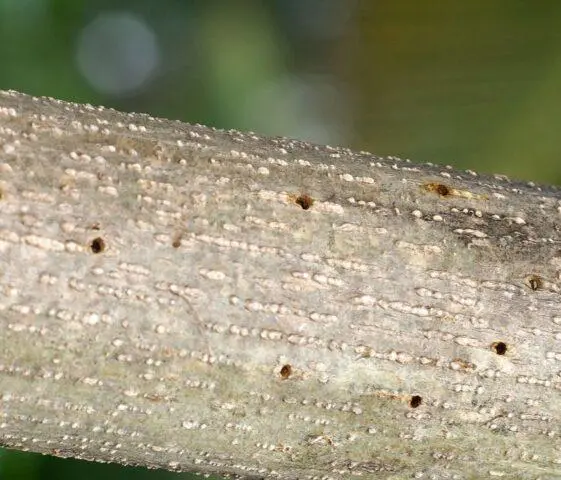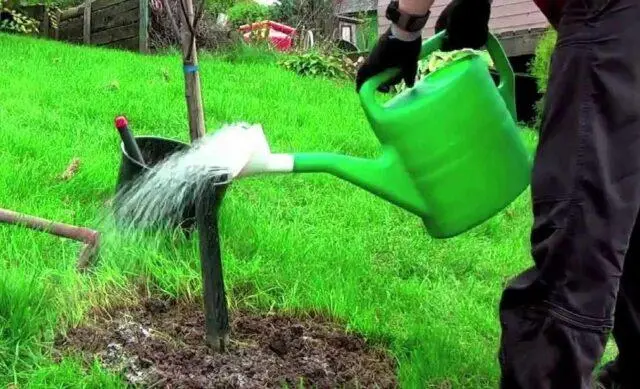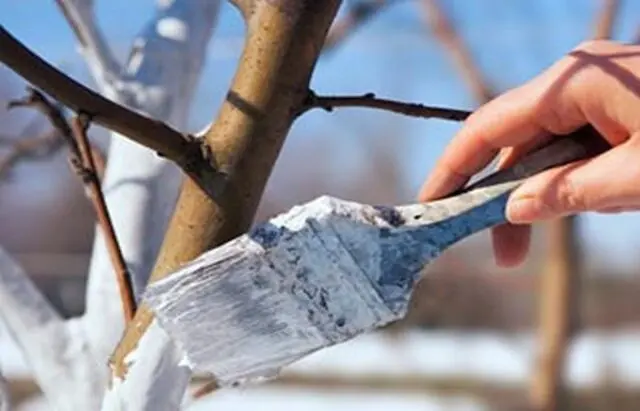Contents
Detachment of the bark of an apple tree is associated with a variety of reasons. Very often, trees suffer from temperature changes in winter. This is a relatively normal phenomenon, after which the bark recovers on its own. Peeling can also occur due to pests, diseases and care errors. For treatment, you need to determine the cause and take appropriate measures.
Why does the bark come off the trunk of an apple tree
The reasons that the bark on an apple tree dies off and leaves with scales are very often associated with diseases or pests, including rodents. Although detachment can be associated with improper care. Often these factors overlap each other, which causes quite serious problems. To deal with them, you first need to determine the cause.
Fungal diseases
If mold forms under the bark, this indicates that the mycelium of one or another type of fungus has damaged the apple tree. Such a case of detachment is considered one of the most dangerous, since it is fraught with the death of an apple tree in a relatively short time. Therefore, it is necessary to immediately begin processing with powerful fungicides (folk remedies will not help).
vermin
Individual pests – woodworms or bark beetles – can also lead to peeling of the bark of an apple tree. Some sources indicate that this is the same species of beetle. Although, in fact, bark beetles are more massive in size, and their body is closer to a rectangular shape. At the same time, in carpenters it is oval and not so large.
Beetles feel good in cool weather (+18-20 °C) and provided that the wood is sufficiently moist. Insects can be detected visually, as they are quite large and reach 3-4,5 mm. The color is brown with dark dots and stripes running along the calf. Larvae are crawling, adult insects are flying because they have wings. Both are active at night, and in the morning they prefer to hide in a layer of bark.

Bark beetles are dangerous pests that can lead to rejection of the surface layer
Rodent damage

Among the rodents that lead to peeling of the bark, the most dangerous are hares and field mice.
They feed on the top layer of wood in early autumn. This leads to tissue damage by frost, which causes even more damage than the pests themselves. Therefore, for prevention, it is necessary to protect the lower part of the trunk by whitewashing and installing a chain-link mesh around.
Temperature differences
Temperature fluctuations have a bad effect on even the most winter-hardy varieties of apple trees. For example, if it warms up to zero degrees in winter or early spring, after which the temperature drops sharply to -15 ° C or more, this can also lead to peeling of the bark of apple trees.
As a result, so-called frost cracks with characteristic “furry edges” are formed on the surface. After removing the damaged area, the underlying layers of wood are visible, which also allows you to reliably confirm the cause associated with a temperature difference.
Solar burns
Sometimes sunburn can also lead to peeling of the bark on an apple tree. At the same time, they contribute not only to the death of the surface layer, but also cause a change in color – it becomes purple or red. The dried layer gives a brown uniform color. The stronger the burn, the deeper it affects the bark of the apple tree, which leads to its exfoliation and death.
Too much nitrogen fertilizer
If the bark of the apple tree has come off and the wood has been exposed, an excess of nitrogen fertilizers may serve as an indirect cause. This element leads to increased growth of different parts of the plant. But if you give it in large quantities, especially in the second half of summer, this will significantly reduce the frost resistance of the tree. In winter, it can suffer greatly, especially with temperature changes. The main blow will fall on the bark and young growth of last year.

Excess nitrogen fertilizers and unbalanced watering can lead to detachment.
Improper care
Improper care can be both an independent cause and an additional factor in combination, for example, with pests or temperature changes. Most often, such errors in agricultural technology lead to peeling of the bark:
- Lack of preventive treatments for diseases and pests.
- There is no shelter of the trunk with roofing felt or other material from rodents.
- Excessive watering contributes to the defeat of fungal diseases.
- Unbalanced top dressing, including excess nitrogen, also leads to peeling of the bark.
How to restore the bark on an apple tree after peeling
It is necessary to remove the exfoliated bark of apple trees and clean the affected area to healthy tissues using a tool or sandpaper. Then it is recommended to cover it with garden pitch, resin, paraffin or fat (in this case, paint should never be used).
Then proceed to treatment. Specific methods depend on the cause of the lesion of the exfoliation of the cortex:
- If mold and other fungi are found, they are treated with fungicides. You can use such drugs: “Bordeaux mixture”, “Fundazol”, “Tattu”, “HOM”, “Ridomil Gold”, “Fitosporin” and others.
- If bark beetles or other pests that led to peeling are found, they start spraying with insecticides, for example: Confidor, Karbofos, Inta-Vir, Agravertin, Tanrek and others.
- In the case of frost crackers, a clay mash is prepared: manure, lime and clay (1: 1: 3). The putty is evenly distributed over the surface so that the layer is not very thick.
- Also, from frost crackers, you can use a different composition of putty based on oily clay (200 g) and finishing putty (100 g). Both components are thoroughly mixed until a mixture with the consistency of fatty sour cream is obtained. Then applied to the pre-cleaned area of delamination.
- If a bark defect is observed at the neck of the tree (i.e., in the trunk area, closer to the ground), it is necessary to prepare a highly concentrated infusion of wood ash (200 g per 1 liter of warm water). A rag is dipped in it and tied in the form of a “compress” on the affected part of the apple tree.
- If there is not only peeling of the surface, but also blackening (the branches seem to be scorched by fire), the apple tree can no longer be helped, since it is affected by black cancer. In this case, you can try to save at least the cuttings, but it’s better not to risk it. It is advisable to buy new seedlings.
- If the exfoliation of the bark of the apple tree is accompanied by rotting, then after stripping, fungicide treatment is carried out, and then allowed to dry and smeared with garden pitch. Instead, you can use natural drying oil (but not paints based on it).

When exfoliating the bark, you need to clean the affected area and treat it with garden pitch
What to do if the bark of young apple trees exfoliates
It is quite realistic to cure the trunk of a young apple tree if the bark has fallen off, especially in the early stages, when the deeper layers of the wood have not been affected. Most often, young seedlings and trees suffer from field mice, hare, as well as from sunburn and frostbite. Moreover, the affected areas do not require treatment as such, since they will recover on their own. To prevent the appearance of defects in the future, it is recommended to observe the following care rules:
- Every spring, whiten the lower part of the trunk to a height of at least 30 cm.
- In early spring, the trunk is protected with a chain-link mesh fragment. Instead, you can wrap it with dense material, for example, burlap, stockings, nylon tights, roofing material. Even old plastic bottles will do.
- If the winters in the region are severe, carefully mulch the plantings with sawdust, manure, and hay. It is better to wrap the trunk of a young seedling with agrofibre, burlap or thick paper.
Prevention of exfoliation
It is always more difficult to treat an apple tree if the bark has departed than to prevent this phenomenon. Weather conditions do not depend on the gardener, but it is possible to provide fairly good care and protection against diseases and pests of the tree. Experienced gardeners recommend:
- Observe the watering rate, apply balanced fertilizer compositions, without violating the rate.
- In autumn, it is necessary to cover up the bare trunk of an apple tree. To do this, use a garden pitch or clay mash. It is necessary to cover the surface with putty even with “planned” damage after autumn pruning.
- Observe the rate of application of nitrogen and other fertilizers, remembering that it is better to slightly underfeed than overfeed. It is also important to consider that nitrogen can only be given in spring and June, and from the beginning of July only superphosphate and potassium supplements can be applied.
- It is imperative to carry out preventive treatments with fungicides and insecticides, especially if in past seasons there were massive insect invasions or fungal and bacterial infections.
- Foliage and pruned branches in autumn should be removed from the site as soon as possible. Pests can overwinter in them, including bark beetles, which lead to exfoliation of the surface layer.

Every spring you need to whitewash the trunks with lime
Conclusion
Detachment of the bark of an apple tree can occur due to improper care, diseases and pests. Even if the cultivation technique is correct, frosts and temperature changes can adversely affect the condition of the trunk. Therefore, the condition of the trees must be monitored and, if necessary, immediately begin treatment.









